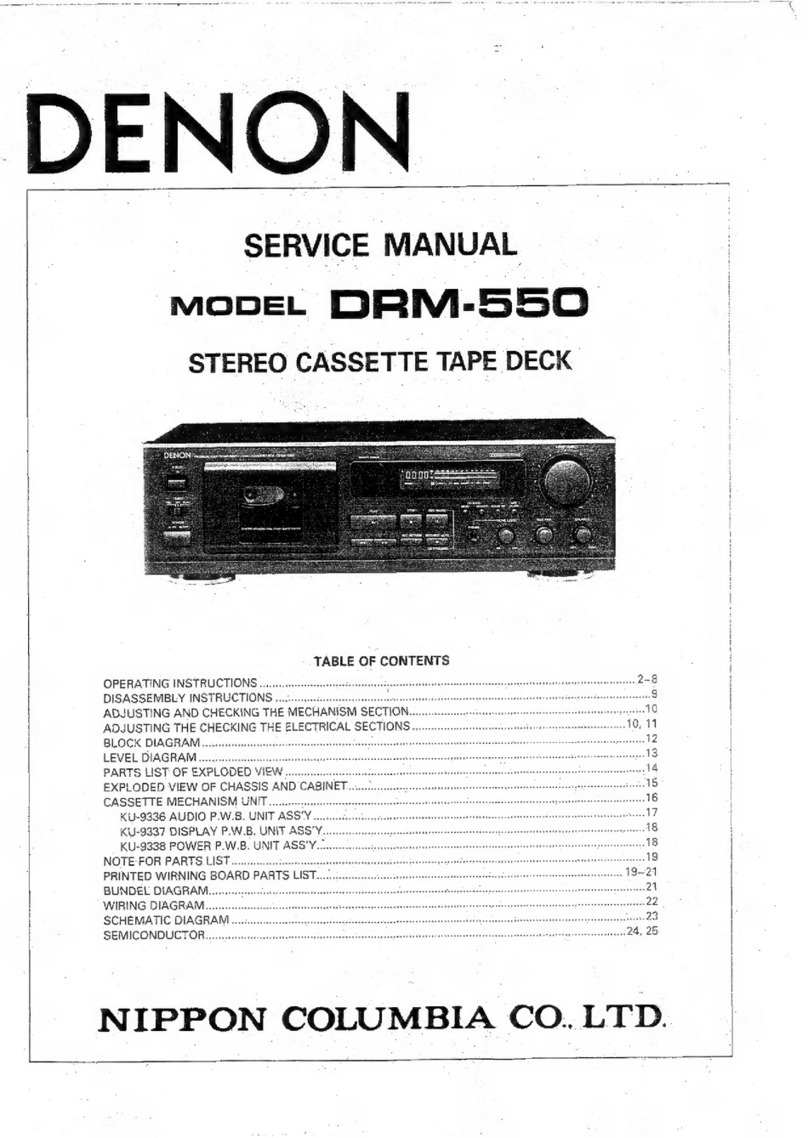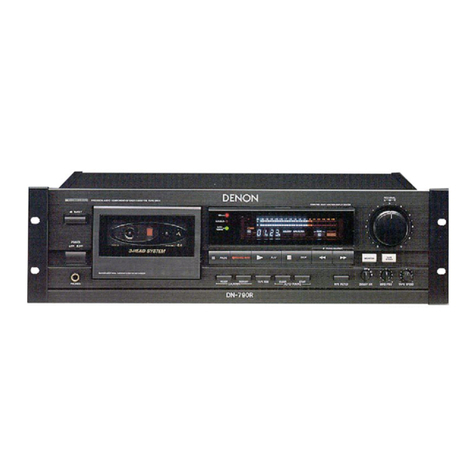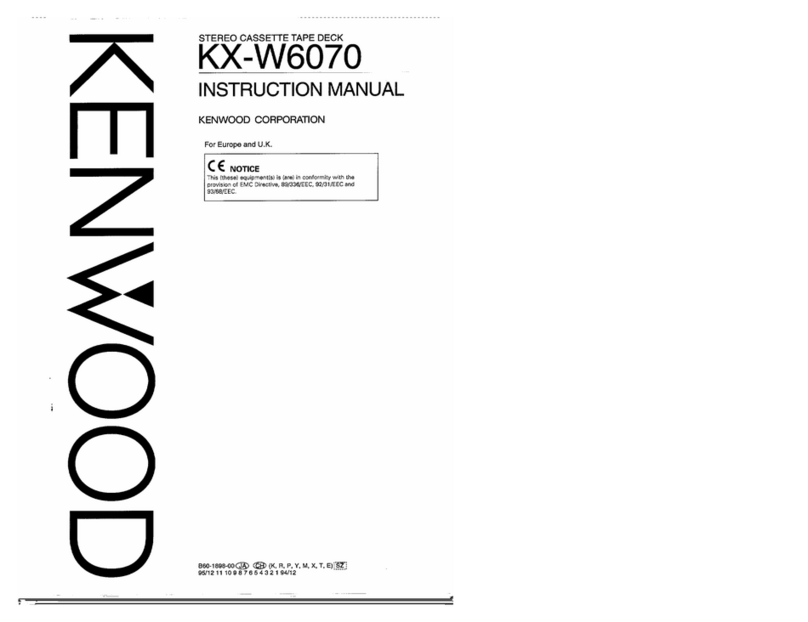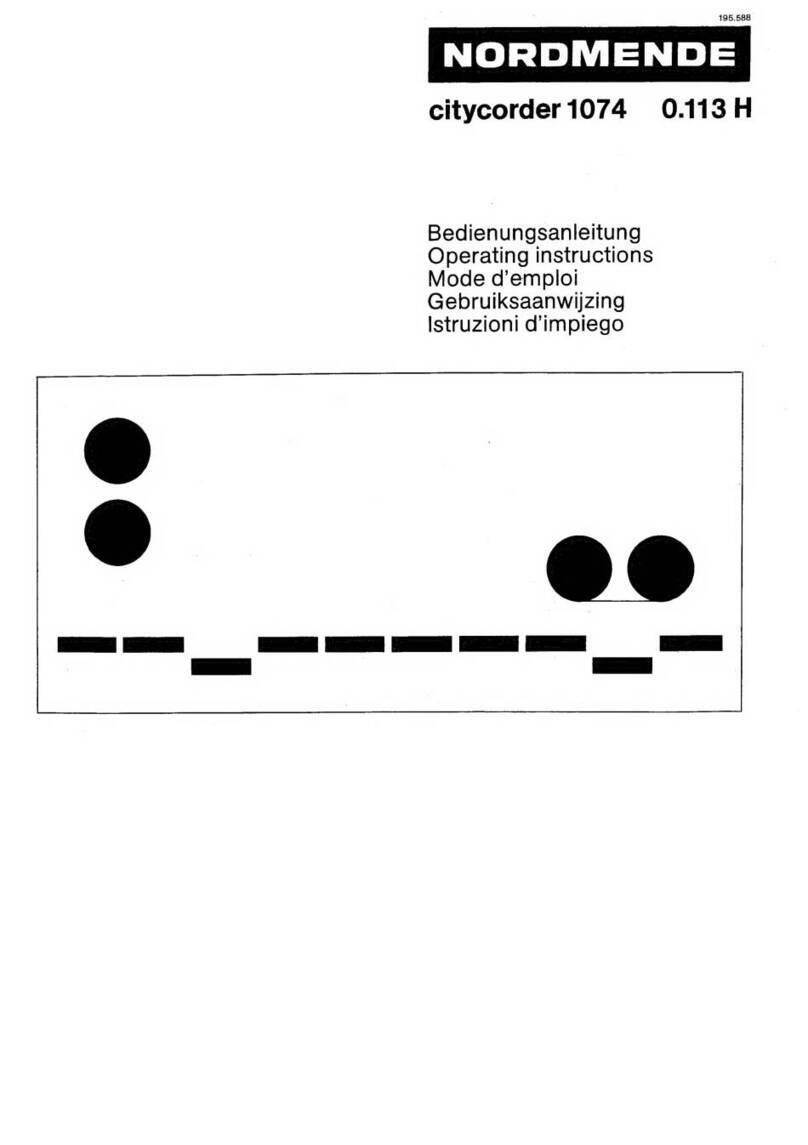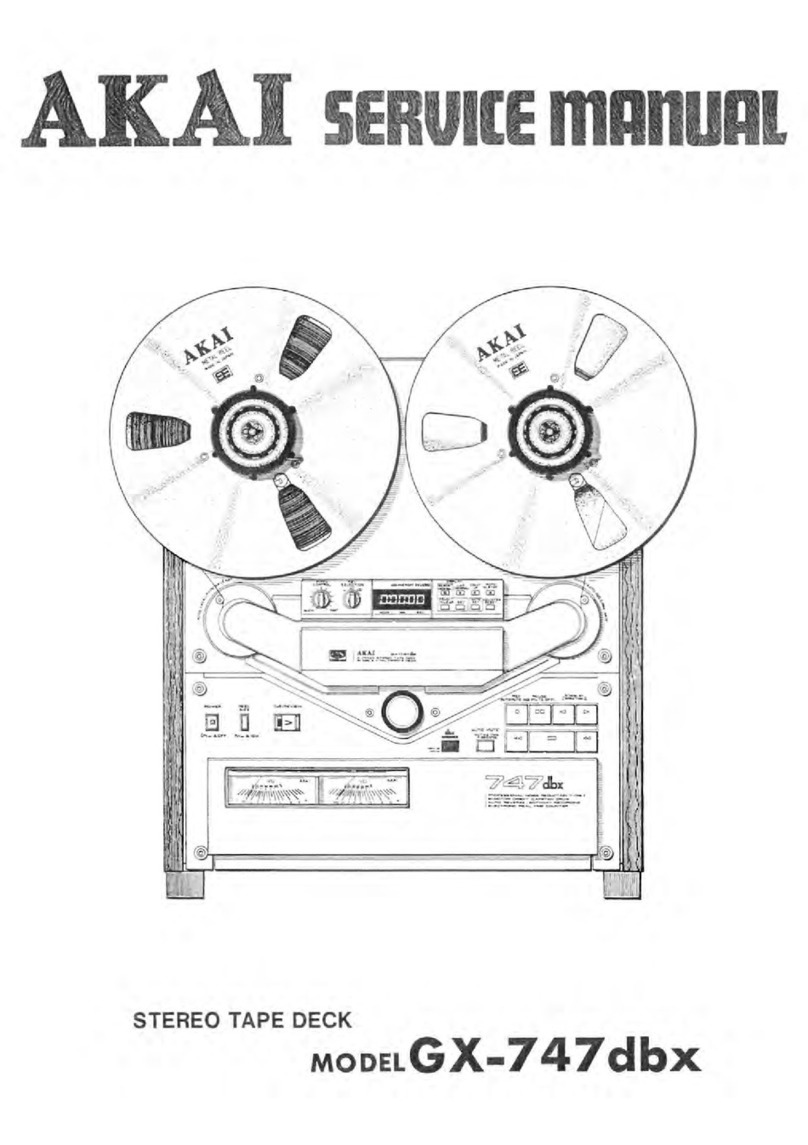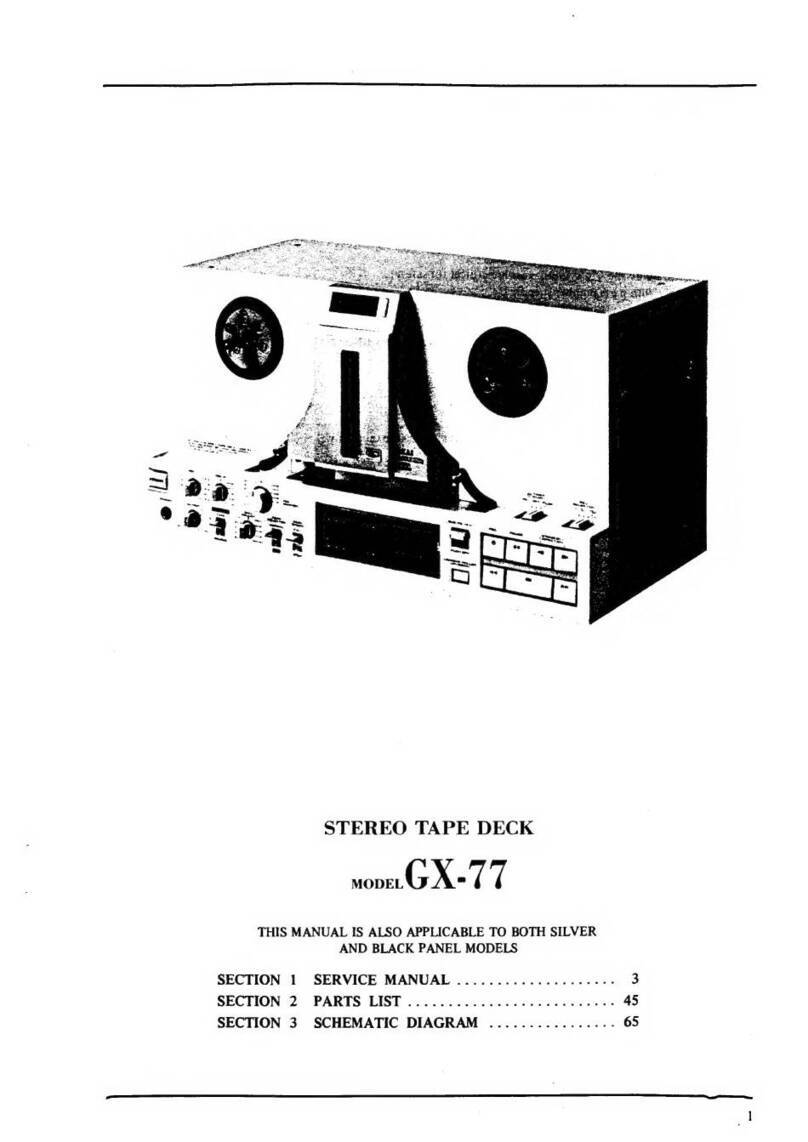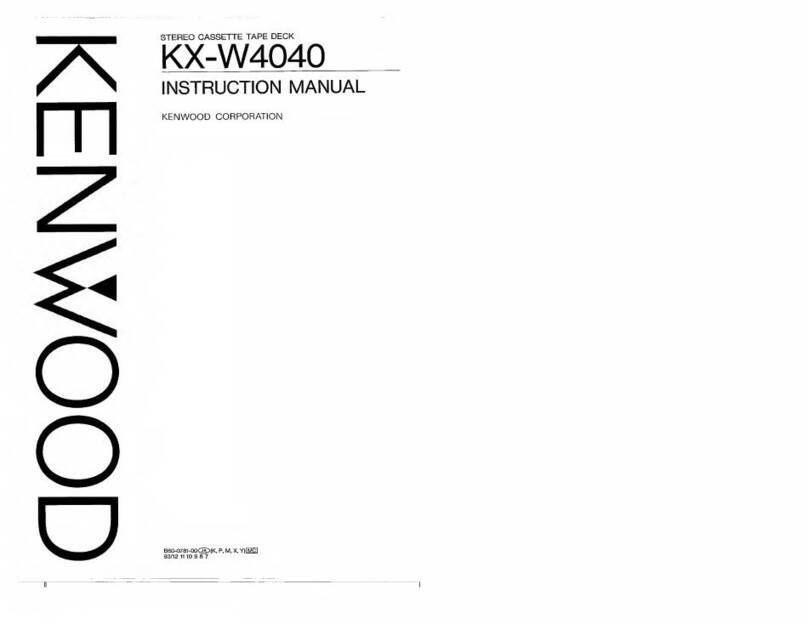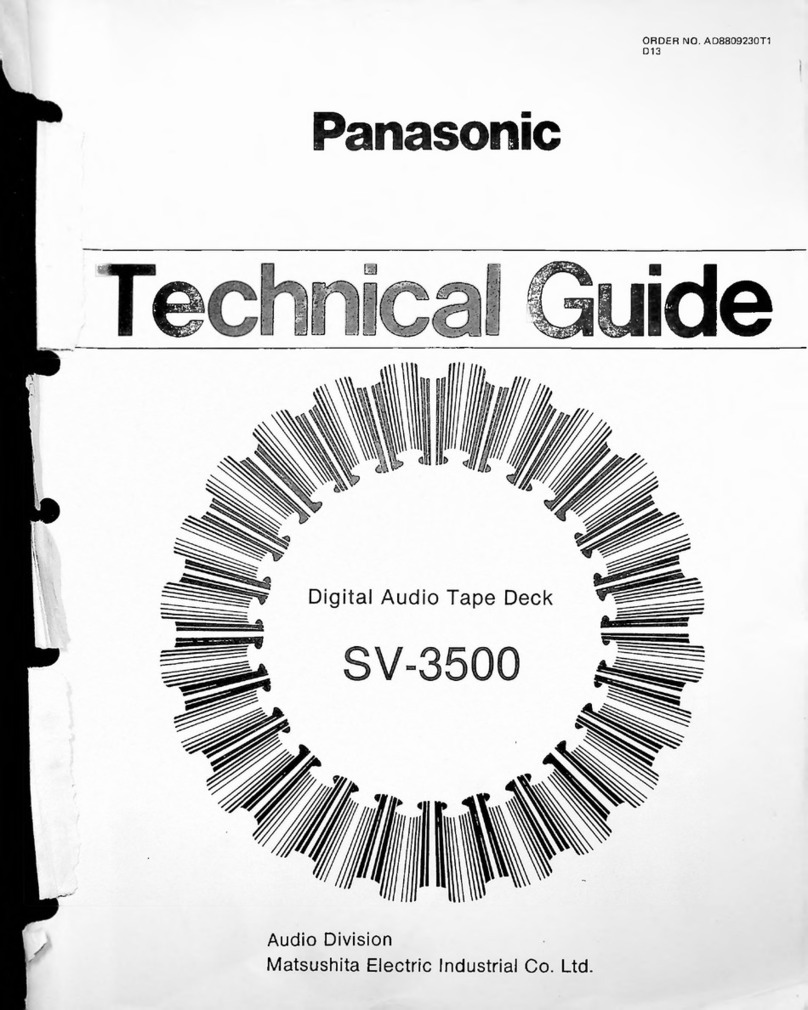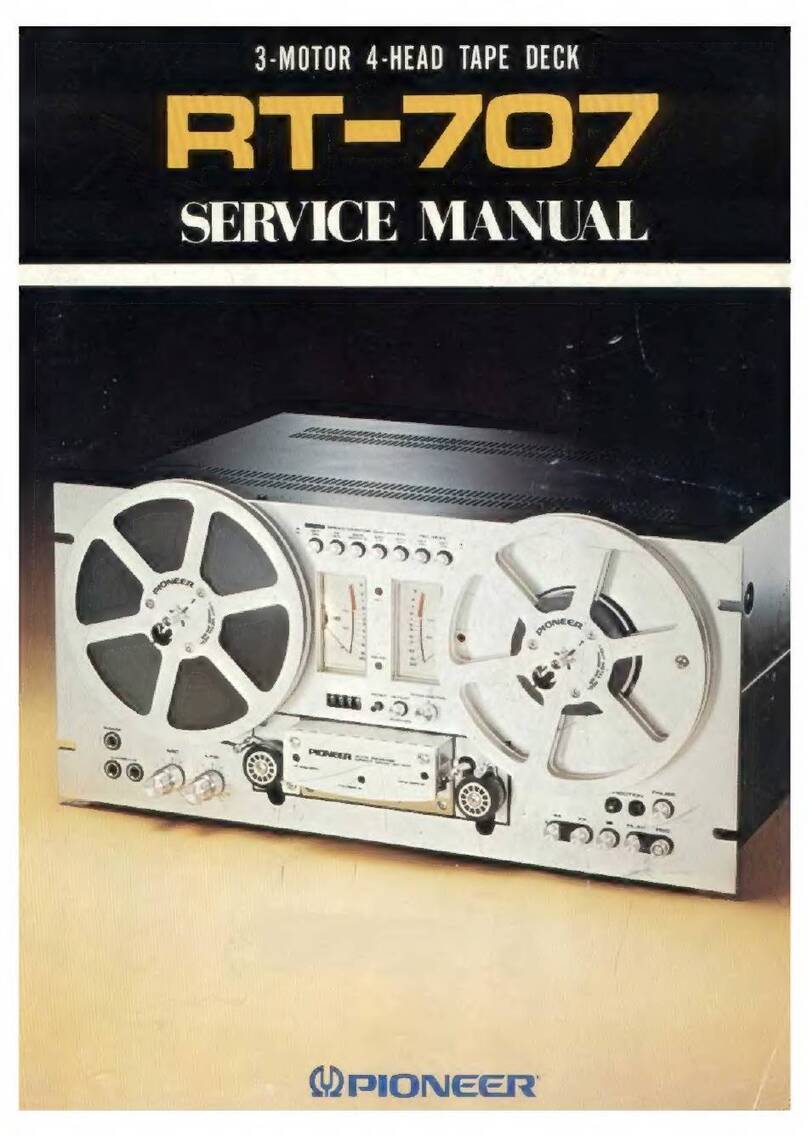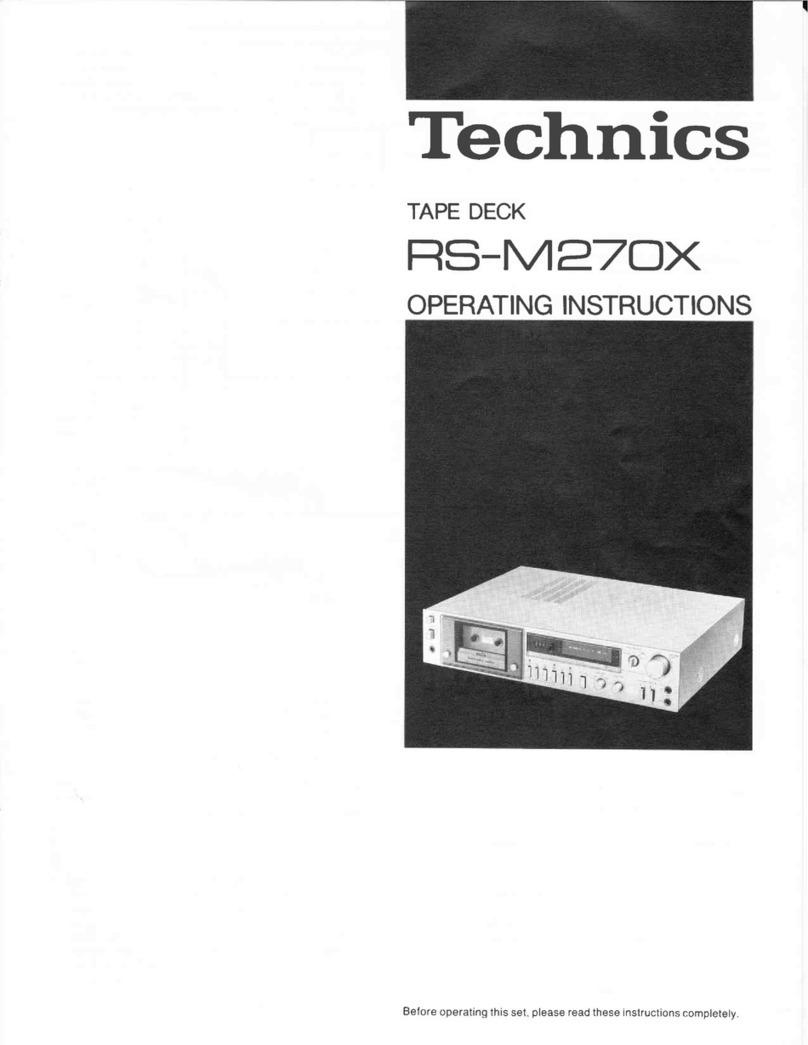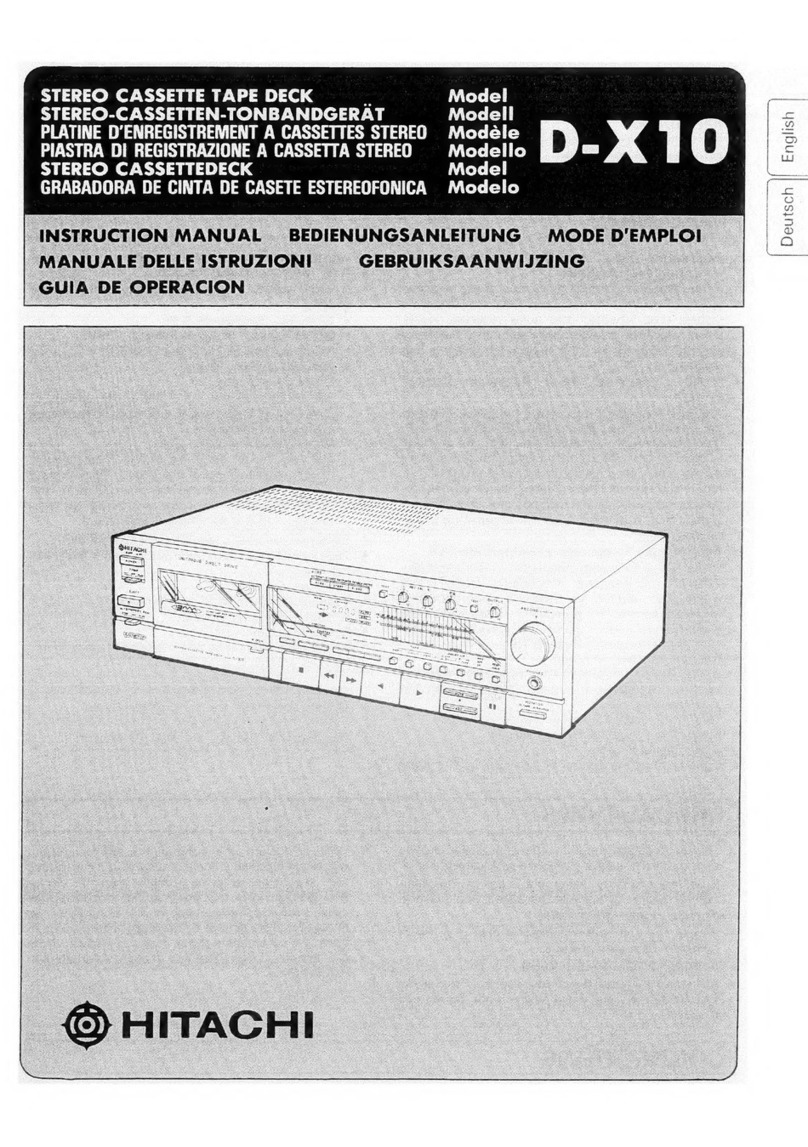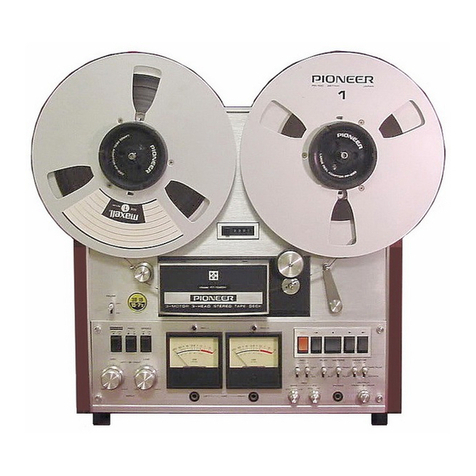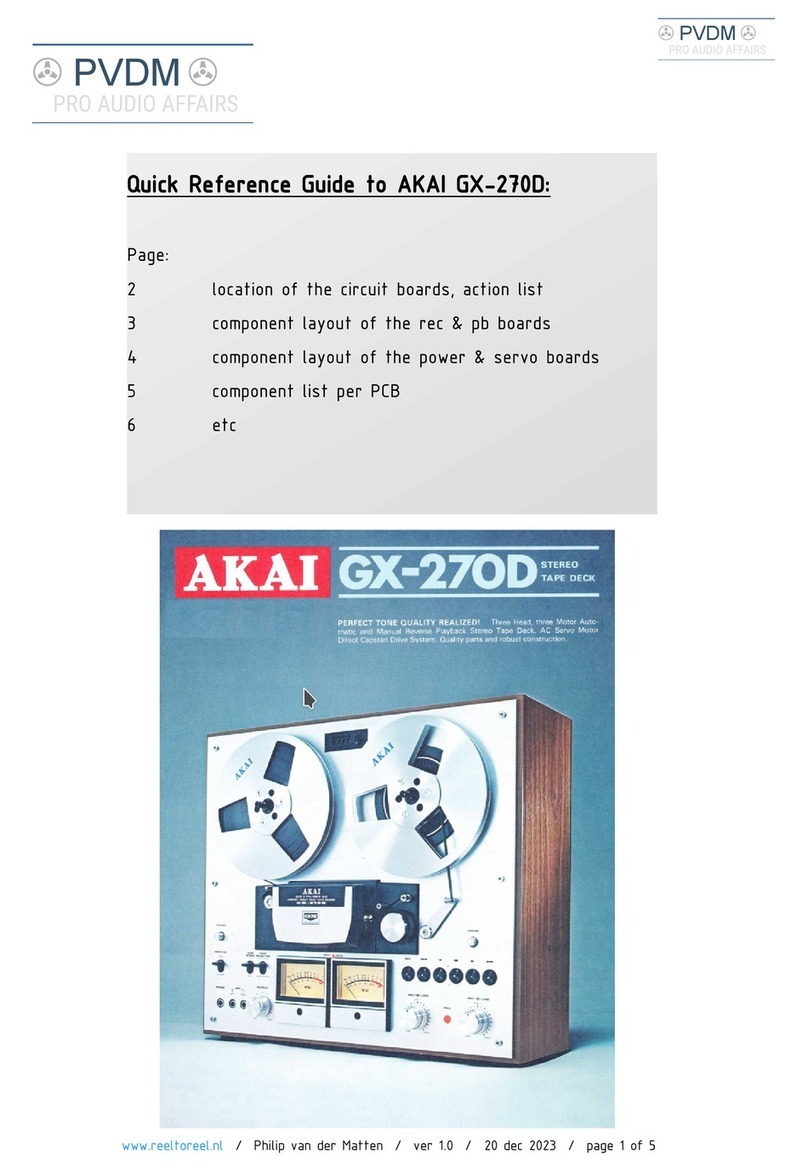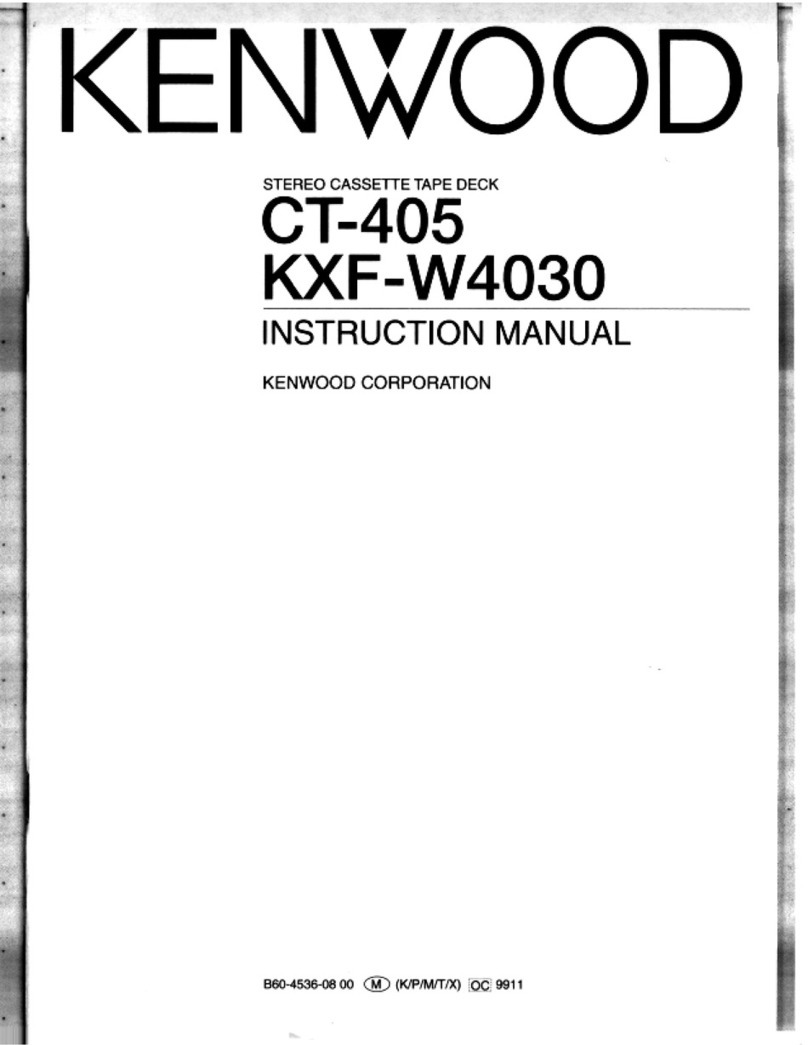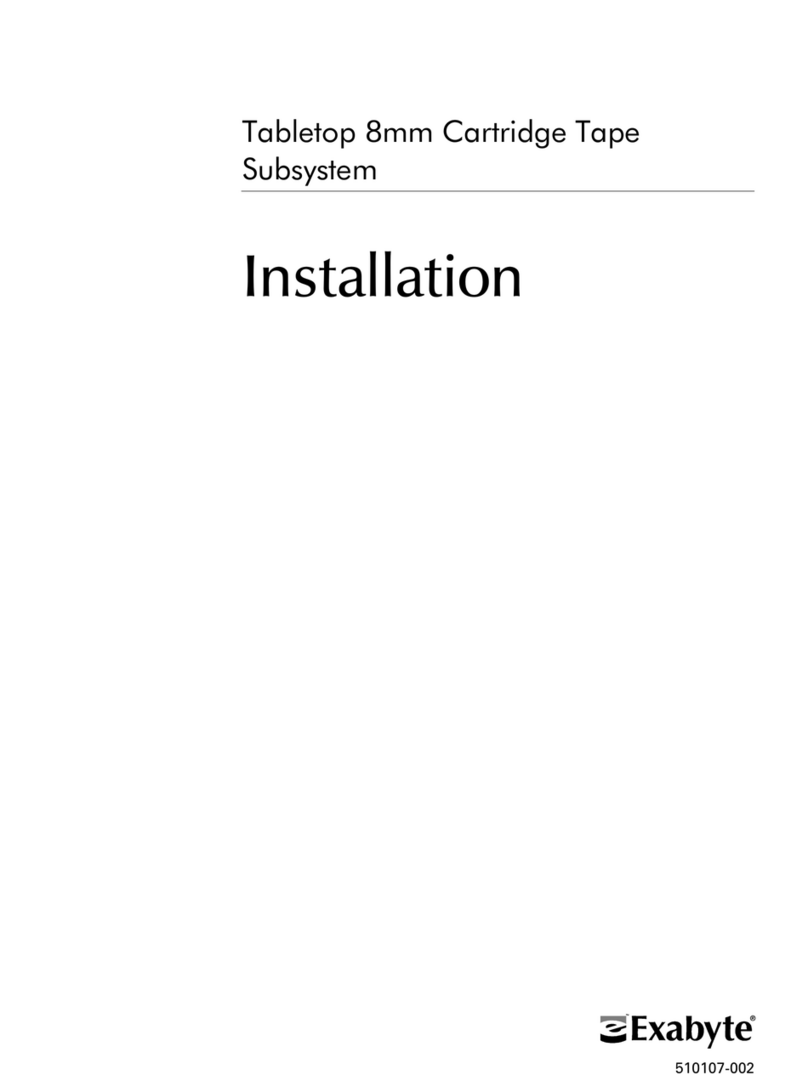Denon DRW-585 User manual

STEREO
CASSETTE
TAPE
DECK
DRW-585
OPERATING
INSTRUCTIONS
MODE
D'EMPLOI
INSTRUCCIONES
DE
OPERACION
FOR
ENGLISH
READERS
PAGE
5
~
PAGE
16
POUR
LES
LECTEURS
FRANCAIS
PAGE
17
~
PAGE
28
PARA
LECTORES
DE
ESPANOL
PAGINA
29
~
PAGINA
37

IMPORTANT
TO
SAFETY
WARNING:
TO
PREVENT
RRE
OR
SHOCK
HAZARD,
DO
NOT
EXPOSE
THIS
APPLIANCE
TO
RAIN
OR
MOISTURE.
CAUTION:
1.
Handle
the
power
supply
cord
carefully
Do
not
damage
or
deform
the
power
supply
cord.
If
it
is
damaged
or
deformed,
it
may
cause
electric
shock
or
malfunction
when
used.
When
removing
it
from
wall
outlet,
be
sure
to
remove
by
holding
the
plug
attachment
and
not
by
pulling
the
cord.
2.
Do
not
open
the
top
cover
In
order
to
prevent
electric
shock,
do
not
open
the
top
cover.
If
problems
occur,
contact
your
DENON
DEALER.
3.
Do
not
place
anything
inside
Do
not
place
metal
objects
or
spill
liquid
inside
the
cassette
tape
deck.
Electric
shock
or
malfunction
may
result.
Please,
record
and
retain
the
Model
name
and
serial
number
of
your
set
shown
on
the
rating
label.
Model
No.
DRW-585
Serial
No-
RISK
OF
ELECTRIC
SHOCK
DO
NOT
OPEN
CAUTION:
TO
REDUCE
THE
RISK
OF
ELECTRIC
SHOCK,
DO
NOT
REMOVE
COVER
(OR
BACK).
NO
USER
SERVICEABLE
PARTS
INSIDE.
REFER
SERVICING
TO
QUALIFIED
SERVICE
PERSONNEL
The
lightning
flash
with
arrowhead
symbol
within
an
equilateral
triangle
is
intended
to
alert
the
user
of
the
presence
of
uninsulated
"dangerous
voltage"
within
the
product's
enclosure
that
may
be
of
sufficient
magnitude
to
constitute
a
risk
of
electric
shock
to
persons.
The
exclamation
point
within
an
equilateral
triangle
is
intended
to
alert
the
user
of
the
presence
of
important
operating
and
maintenance
(servicing)
instruction
in
the
literature
accompanying
the
ap¬
pliance.
•
FOR
U
S
A-
A
CANADA
MODEL
ONLY
CAUTION
TO
PREVENT
ELECTRIC
SHOCK
DO
NOT
USE
THIS
(POLARIZED)
Pltfit
WITH
AN
EXTENSION
CORD,
RECEPTACLE
OR
OTHER
OUTLET
UNLESS
THE
BLADES
CAN
BE
FULLY
INSERTED
TO
PREVENT
8LADE
EXPOSURE.
•
POUR
LES
MODELES
AMERICANS
ET
CANADIENS
UMQUEMENT
_
ATTENTION
_
'
POUR
PREVENIR
LES
CHOCS
ELECTRIQUES
NE
PAS
UTILISER
CETTE
FICHE
POLARISEE
AVEC
UN
PROLONGATEUR
UNE
PRISE
DE
COU-
RANT
OU
UNE
AUTRE
SORTIE
DE
COURANT,
SAUF
SI
LES
LAMES
PEUVENT
ETRE
INSEREES
A
FOND
SANS
EN
LAISSER
AUCUNE
PARTIE
A
DECOUVERT.
This
device
complies
with
Part
15
of
the
FCC
Rules.
Operation
is
subject
to
the
following
two
conditions:
(1)
This
device
may
not
cause
harmful
interference,
and
(2)
this
device
must
accept
any
interference
received,
including
interference
that
may
cause
undesired
operation.
This
Class
B
digital
apparatus
meets
all
requirements
of
the
Canadian
In¬
terference-Causing
Equipment
Regulations.
Cet
appareil
num6rique
de
la
classe
B
respecte
toutes
les
exigences
du
Rdglement
sur
le
materiel
brouilleur
du
Canada.

SAFETY
INSTRUCTIONS
1.
Read
Instructions
-
All
the
safety
and
operating
instructions
should
be
read
before
the
appliance
is
operated.
2.
Retain
Instructions
-
The
safety
and
operating
instructions
should
be
retained
for
future
reference.
3.
Heed
Warnings
-
All
warnings
on
the
appliance
and
in
the
operating
instructions
should
be
adhered
to.
4.
Follow
Instructions
-
All
operating
and
use
instruc¬
tions
should
be
followed.
5.
Water
and
Moisture
-
The
appliance
should
not
be
used
near
water
-
for
example,
near
a
bathtub,
washbowl,
kitchen
sink,
laundry
tub,
in
a
wet
basement,
or
near
a
swimming
pool,
and
the
like.
6.
Carts
and
Stands
-
The
appliance
should
be
used
only
with
a
cart
or
stand
that
is
recommended
by
the
manufacturer.
6A.
An
appliance
and
cart
combination
should
be
moved
with
care.
Quick
stops,
excessive
force,
and
uneven
surfaces
may
cause
the
appliance
and
cart
7.
Wall
or
Ceiling
Mounting
-
The
appliance
should
be
mounted
to
a
wall
or
ceiling
only
as
recommended
by
the
manufacturer.
8.
Ventilation
-
The
appliance
should
be
situated
so
that
its
location
or
position
does
not
interfere
with
its
proper
ventilation.
For
example,
the
appliance
should
not
be
situated
on
a
bed,
sofa,
rug,
or
similar
surface
that
may
block
the
ventilation
openings;
or,
placed
in
a
built-in
installation,
such
as
a
bookcase
or
cabinet
that
may
impede
the
flow
of
air
through
the
ventilation
openings.
9.
Heat
-
The
appliance
should
be
situated
away
from
heat
sources
such
as
radiators,
heat
registers,
stoves,
or
other
appliances
(including
amplifiers)
that
produce
heat.
10.
P
o
w
er
Sources-The
appliance
should
be
connected
to
a
power
supply
only
of
the
type
described
in
the
operating
instructions
or
as
marked
on
the
ap¬
pliance.
combination
to
overturn.
11.
G
r
ounding
or
Polarization
-
Precautions
should
be
taken
so
that
the
grounding
or
polarization
means
of
an
appliance
is
not
defeated.
FIGURE
A
EXAMPLE
OF
ANTENNA
GROUNDING
AS
PER
NATIONAL
ELECTRICAL
CODE
ANTENNA
DISCHARGE
UNIT
(NIC
SECTION
810
HI
GROUND
CLAMPS
12.
P
o
w
e
r
-
C
o
r
d
Protection
-
Power-supply
cords
should
be
routed
so
that
they
are
not
likely
to
be
walked
on
or
pinched
by
items
placed
upon
or
against
them,
paying
particular
attention
to
cords
at
plugs,
con¬
venience
receptacles,
and
the
point
where
they
exit
from
the
appliance.
14.
Cleaning
-
The
appliance
should
be
cleaned
only
as
recommended
by
the
manufacturer.
15.
Power
Lines
-
An
outdoor
antenna
should
be
located
away
from
power
lines.
16.
Outdoor
Antenna
Grounding
-
If
an
outside
antenna
is
connected
to
the
receiver,
be
sure
the
antenna
system
is
grounded
so
as
to
provide
some
protec¬
tion
against
voltage
surges
and
built-up
static
charges.
Article
810
of
the
National
Electrical
Code,
ANSI/NFPA
70,
provides
information
with
regard
to
proper
grounding
of
the
mast
and
supporting
struc¬
ture,
grounding
of
the
lead-in
wire
to
an
antenna-
discharge
unit,
size
of
grounding
conductors,
loca¬
tion
of
antenna-discharge
unit,
connection
to
grounding
electrodes,
and
requirements
for
the
grounding
electrode.
See
Figure
A.
17.
Nonuse
Periods
-
The
power
cord
of
the
appliance
should
be
unplugged
from
the
outlet
when
left
unused
for
a
long
period
of
time.
18.
Object
and
Liquid
Entry
-
Care
should
be
taken
so
that
objects
do
not
fall
and
liquids
are
not
spilled
into
the
enclosure
through
openings.
19.
Damage
Requiring
Service
-
The
appliance
should
be
serviced
by
qualified
service
personnel
when:
A.
The
power-supply
cord
or
the
plug
has
been
damaged;
or
B.
Objects
have
fallen,
or
liquid
has
been
spilled
into
the
appliance;
or
C.
The
appliance
has
been
exposed
to
rain;
or
D.
The
appliance
does
not
appear
to
operate
normal¬
ly
or
exhibits
a
marked
change
in
performance;
or
E.
The
appliance
has
been
dropped,
or
the
enclosure
damaged.
20.
Servicing
-
The
user
should
not
attempt
to
service
the
appliance
beyond
that
described
in
the
operating
instructions.
All
other
servicing
should
be
referred
to
qualified
service
personnel.
NEC
-
NATIONAL
ELECTRICAL
CODE
POWER
SERVICE
GROUNDING
CLECTRQOt
SYSTEM
(NEC
ART
ISO,
PART
Ml
3

NOTE
ON
USE/OBSERVATIONS
RELATIVES
A
L'UTILISATION/NOTAS
SOBRE
EL
USO
•
Avoid
high
temperatures
Allow
for
sufficient
heat
dispersion
when
installed
on
a
rack.
•
Eviter
des
temperatures
dlevdes
Tenir
compte
d'une
dispersion
de
chaleur
suffisante
lors
de
['installa¬
tion
sur
une
dtagdre.
•
Evite
altas
temperaturas
Permite
la
suficiente
dispersidn
del
calor
cuando
estd
instalado
en
la
con-
sola.
•
Handle
the
power
cord
carefully.
Hold
the
plug
when
unplugging
the
cord.
•
Manipuler
le
cordon
d'alimentation
avec
precaution.
Tenir
la
prise
lors
du
debranchem’ent
du
cordon.
•
Maneje
el
corddn
de
energfa
con
cui-
dado.
Sostenga
el
enchufe
cuando
desco-
necte
el
corddn
de
energi'a.
•
Keep
the
set
free
from
moisture,
wa¬
ter,
and
dust.
•
Protdger
I'appareil
contre
I'humidite,
I'eau
et
la
poussidre.
•
Mantenga
el
equipo
libre
de
hume-
dad,
agua
y
polvo.
•
Unplug
the
power
cord
when
not
us¬
ing
the
set
for
long
periods
of
time.
•
Ddbrancher
le
cordon
d'alimentation
lorsque
I'appareil
n'est
pas
utilisd
pen¬
dant
de
longues
pdriodes.
•
Desconecte
el
corddn
de
energfa
cuando
no
utilice
el
equipo
por
mucho
tiempo.
*(For
sets
with
ventilation
holes)
•
Do
not
obstruct
the
ventilation
holes.
•
Ne
pas
obstruer
les
trous
d'adration.
•
No
obstruya
los
orificios
de
ventila-
cidn.
I'appareil.
•
Do
not
let
foreign
objects
in
the
set.
•
Ne
pas
laisser
des
objets
dtrangers
dans
I'appareil.
•
No
deje
objetos
extrahos
dentro
del
equipo.
•
Do
not
let
insecticides,
benzene,
and
thinner
come
in
contact
with
the
set.
•
Ne
pas
mettre
en
contact
des
insecti¬
cides.
du
benzdne
et
un
diluant
avec
permita
el
contacto
de
insectici-
das,
gasolina
y
diiuyentes
con
el
equi¬
po.
•
Never
disassemble
or
modify
the
set
in
any
way.
•
Ne
jamais
ddmonter
ou
modifier
I'ap-
pareil
d'une
manidre
ou
d'une
autre.
•
Nunca
desamne
o
modifique
el
equi¬
po
de
ninguna
manera.

ENGLISH
Thank
you
very
much
for
purchasing
the
DENON
component
stereo
cassette
tape
deck,
DENON
proudly
presents
this
advanced
tape
deck
to
audiophiles
and
music
lovers
as
a
further
proof
of
DENON's
non-compromising
pursuit
of
the
ultimate
in
sound
quality.
The
high
quality
performance
and
easy
operation
are
certain
to
provide
you
with
many
hours
of
outstanding
listening
pleasure.
—
TABLE
OF
CONTENTS
—
FEATURES.
5
CONNECTION.
5
NAMES
AND
FUNCTION
OF
PARTS.
6,
7
CASSETTE
TAPES.
7
AUTOMATIC
TAPE
SELECTION
.
8
PLAYBACK.
8
RELAY
PLAY.
9
MUSIC
SEARCH
SYSTEM
.
9
RECORDING
.
10
PROPER
RECORDING
LEVEL.
11
RECORDING
BIAS
ADJUSTMENT.
11
REC/REC
MUTE
AND
REC
PAUSE
BUTTON.
11
DIMMER
ADJUSTMENT.
11
DUBBING
..
12
SYNCHRONIZED
RECORDING
FUNCTION
.
12.13
TAPE
COUNTER
AND
MEMORY
STOP.
13
TIMER
RECORDING/PLAYBACK.
14
DOLBY
B
AND
C
NOISE
REDUCTION
SYSTEM.
14
DOLBY
HX-PRO
HEADROOM
EXTENSION
SYSTEM
.
15
MAINTENANCE.
15
TROUBLESHOOTING.
16
SPECIFICATIONS
.
16
Please
check
to
make
sure
the
following
items
are
included
with
the
main
unit
in
the
carton:
(1)
Operating
Instructions.
1
(2)
Connection
Cords
.
2
(3)
Mini-Plug
Cable.
1
FEATURES_
■
Computer
Controlled
Mechanism
■
Dual
Power
Supply
■
Dolby
HX-Pro
Headroom
Extension
System
■
Dolby
B
&
C
Noise
Reduction
Systems
■
Manual
Bias
Adjustment
Control
■
Dual
Computing
Tape
Counter
with
4-Digit
Readout
and
Memory
Stop
■
Music
Search
System
■
FL
Peak
Level
Meters
■
Auto
Tape
Selector
■
2-Speed
Dubbing
■
Relay
Playback
■
Synchronized
Recording
■
Timer
Play
and
Timer
Recording
■
Optional
Remote
Controllable
■
Tape
Lighting
CONNECTION_
•
Leave
your
entire
system
(including
this
cassette
deck)
turned
off
until
all
connections
between
the
deck
and
other
components
have
been
completed.
Receiver
or
amplifier
DRW-585
■
Connecting
the
Deck
to
an
Amplifier
•
Before
connecting
the
deck
to
your
amplifier,
please
review
your
amplifier's
instruction
manual.
•
Use
the
white
plugs
for
the
left
channel
and
red
plugs
for
the
right
channel.
■
Tape
Dubbing
•
Many
stereo
amplifiers
and
receivers
have
tape
dubbing
circuitry
so
that
tape
duplication
can
be
performed
between
two
or
more
tape
decks.
Review
your
amplifier's
instruction
manual
for
a
full
explanation
of
this
mode
of
operation.
■
Connecting
Headphones
To
listen
through
headphones,
plug
your
headphones
into
the
PHONES
jack.
■
Installation
Precautions
If
the
deck
is
placed
near
an
amplifier,
TV
or
tuner,
noise
(induced
hum)
or
beat
interference
may
result,
especially
during
FM
or
AM
reception.
If
this
occurs,
place
the
deck
further
away
from
other
components
or
reorient
its
position.
—
Caution-
A
mechanical
sound
is
heard
the
first
time
the
power
switch
is
set
to
"ON"
after
the
power
cord
is
plugged
into
an
outlet.
This
is
the
sound
of
the
cassette
mechanism
being
set
to
the
proper
operating
state,
and
is
normal.
(When
using
an
AC
outlet
on
a
receiver
or
amplifier,
used
an
"UNSWITCHED"
outlet.)
5

ENGLISH
NAMES
AND
FUNCTIONS
OF
PARTS
o
0
0
o
e
o
o
©
Power
Operation
Switch
Press
once
to
turn
the
power
to
deck
on,
and
once
more
to
turn
the
power
off.
The
deck
remains
in
a
stand-by
(non-operative)
mode
for
approx¬
imately
2
seconds
after
it
is
switched
on.
Eject
Button
(
A
)
Press
this
button
to
open
the
cassette
compartment
cover.
When
the
tape
is
running,
press
the
STOP
(
■
)
button
first
to
stop
tape
transport,
then
press
the
Eject
button.
Counter
Reset
Button
(COUNTER
RESET)
Press
this
button
to
reset
the
tape
counter
to
zero.
MPX
Filter
Button
(MPX)
The
MPX
FILTER
button
should
be
used
to
prevent
interference
with
the
Dolby
NR
circuit
when
making
Dolby
NR
encoded
recordings
of
FM
stereo
programs.
When
making
Dolby
NR
encoded
recordings
from
any
program
source
other
than
FM
stereo,
leave
this
button
in
the
"OFF"
position.
Counter
Memory
Button
(MEMORY)
When
this
button
is
pressed
during
forward
tape
travel
(M,
fast
rewinding
(
44
)
will
stop
automatically
at
the
tape
counter
position
"
00
0
0
"
.
When
this
button
is
pressed
during
reverse
tape
travel
(0),
fast
forwarding
(
►►
)
will
stop
automatically
at
the
tape
counter
position
"
0
000
"
.
See
page
13.
Dolby
NR
Switch
(DOLBY
NR)
To
record
or
playback
tapes
with
Dolby
B
or
C-type
noise
reduction,
set
this
switch
to
"B"
or
T.
Turn
it
"OFF"
when
not
using
the
Dolby
NR
system.
Reverse
Mode
Switch
(REV.
MODE)
Select
the
type
of
tape
transport.
The
reverse
mode
canbe
set
to
(one
side),
r^~)(continuous
playback),
RELAY
(relay
playback).
Dubbing
Speed
Buttons
(DUBBING
SPEED)
Pressing
the
NORMAL
button
starts
regular
speed
dubbing
from
deck
A
to
deck
B.
Press
the
HIGH
button
to
perform
dubbing
at
double
speed.
See
page
12.
0
Bias
Fine
Control
(BIAS
FINE)
(For
Normal,
Cr0
2
and
Metal
tape)
Use
this
control
to
fine-adjust
the
bias.
Standard
bias
is
obtained
at
the
center
click-stop
position.
See
page
11.
4jj)
Input
Level
Control
(INPUT
LEVEL)
This
knob
adjusts
the
recording
input
level.
It
affects
the
level
in
both
channels.
See
page
10.
0
Tape
Lighting
The
tape
lighting
makes
it
possible
to
clearly
check
the
amount
of
tape
remaining.
®
Cassette
Compartment
Cover
If
the
cover
is
not
closed
completely,
the
tape
transport
buttons
will
remain
inoperative.
<§)
Headphone
Jack
(PHONES)
For
private
music
enjoyment
without
disturbing
others,
or
for
monitoring
a
recording,
a
headphone
set
may
be
connected
to
this
jack.
Use
a
headphone
with
an
impedance
rating
of
8
to
1200
ft/ohms.
0
Remote
Sensor
(REMOTE
SENSOR)
With
DRW-585
the
remote
control
unit
is
not
included.
Each
of
"PLAY,
FF,
REW,
STOP,
REC
PAUSE
and
REC/REC
MUTE"
functions
can
be
remote
controlled
with
wireless
handset
of
the
receiver
(DRA
Series
receivers).
For
details
refer
to'the
DRA
Series
operating
instructions.
NOTE:
Note
that
only
the
A
deck
can
be
operated
with
remote
control
units
which
have
no
A/B
selector
button.
-Caution:--
Whenever
the
power
switch
is
in
the
OFF
state,
the
apparatus
is
still
connected
on
AC
line
voltage.
Please
be
sure
to
unplug
the
cord
when
you
leave
home
for,
say,
a
vacation.
0
Timer
Switch
(TIMER)
This
switch
is
provided
for
use
with
an
optional
audio
timer
for
unattended
recording
or
morning-alarm
playback.
For
non-timer
operation,
this
switch
should
be
set
in
the
"OFF"
position.
See
page
14.
6

ENGLISH
©
Tape
Transport
Buttons
PLAY
Play
Button
Press
to
playback
tape.
■
Stop
Button
Press
to
stop
the
tape
in
any
mode.
M
Fast
Rewind
Button
Press
for
fast
rewind.
Fast
Forward
Button
Press
for
fast
forwarding.
•
REC/REC
MUTE
(Deck
B
only)
Rec/Rec
Mute
Button
Press
the
REC/REC
MUTE
(•)
button
and
PLAY
button
simultaneously
to
start
recording.
If
only
the
REC/REC
MUTE
(•)
button
is
pressed,
the
deck
enters
the
Recording
Pause
mode.
Pressing
this
button
in
the
Recording
Pause
mode
will
start
Auto
Rec
Mute,
and
a
5-second
silent
space
is
recorded
onto
the
tape.
See
page
11.
II
REC
PAUSE
(Deck
B
only)
Rec
Pause
Button
Press
this
button
to
enter
the
recording
pause
mode
from
the
recording
or
recording
mute
mode.
This
button
can
only
be
used
during
recording.
See
page
11.
Direction
Button
Changes
the'tape
transport
direction
from
forward
to
reverse
“4",
and
vice
versa.
®
Display
Indicators
with
an
encircled
number
light
up
when
the
corresponding
button
is
pressed.
.Deck
A
Tape
Transport
Indicators
Peak
Level
Meter
Indicates
the
recording
and
playback
signal
levels
for
the
left
and
right
channels.
-40
-30
-20
xrrp:
-10
-5
-3
-1
0
+1
+3
+5
+10
□
□□□□□
Daaaannonac
m
m
-
HIGH-i
MEMO—
LJ
LJ
LJ
LJ
DUB-
®MPX
fUUUO
SYNC
Deck
A
Tape
Counter
-MPX
Filter
Indicator
-
Remote
Control
Indicator
Deck
A
Memory
Indicator
~S888
<1DH
QM
MBMOf
■
Deck
8
Tape
Counter
•
Dubbing
Speed
Indicators
-Deck
B
Tape
Transport
Indicators
.
Deck
B
Memory
Indicator
■
S
ynchro
Rec
Indicator
See
pages
12,
13
CASSETTE
TAPES
■
Handling
Precautions
•
C-120
Cassettes
C-120
cassette
tapes
are
not
recommended
as
they
use
a
very
thin
tape
base
which
may
become
tangled
around
the
capstan
or
pinch
roller.
•
Tape
Slack
Before
putting
a
tape
into
the
deck,
take
up
any
slack
with
a
pencil
or
your
finger
tip.
This
precaution
prevents
the
tape
from
becoming
entangled
around
the
capstan
or
pinch
roller.
■
Storage
Precautions
•
Do
not
store
cassette
tapes
in
a
place
where
they
will
be
subject
to:
•
Extremely
high
temperature
or
excessive
moisture
•
Excessive
dust
•
Direct
sunlight
•
Magnetic
fields
(near
TV
sets
or
speakers)
•
To
eliminate
tape
slack,
store
your
cassettes
in
cassette
cases
with
hub
stops
■
Accidental
Erasure
Prevention
•
All
cassettes
have
erasure
prevention
tabs
for
each
side.
To
protect
valuable
recordings
from
accidental
or
inadvertent
erasure,
remove
the
tab
for
the
appropriate
side
with
a
screwdriver
or
another
tool.
•
To
record
on
a
tape
whose
erasure
prevention
tabs
have
been
removed,
cover
the
tab
holes
with
adhesive
tape.
Erasure
prevention
tab
for
side
B
7

ENGLISH
AUTOMATIC
TAPE
SELECTION
This
Stereo
Cassette
Deck
contains
an
automatic
tape
selector
which
automatically
selects
the
optimum
bias
and
equalization
for
the
tape
in
use.
This
is
accomplished
by
detection
of
the
tape
type
detections
holes
in
the
cassette
housing.
PLAYBACK_
•
The
operations
described
below
apply
to
deck
A
and
deck
B
alike.
•
Switch
on
your
amplifier
or
receiver.
•
Set
the
Tape
Monitor
switch
on
your
amplifier
or
receiver
to
the
TAPE
position.
•
The
numbers
in
the
illustration
below
depict
the
order
in
which
operation
steps
are
carried
out.
©
Press
the
POWER
switch
to
the
ON
(
»
)
position.
(D
Press
the
EJECT
(
—
)
button
to
open
the
cassette
compartment
cover.
©
Load
the
cassette
tape
and
close
the
cassette
compartment
cover.
(
4
)
When
listening
to
a
tape
that
has
been
recorded
with
Dolby
noise
reduction,
set
the
DOLBY
NR
switch
to
match
the
system
used
at
the
time
of
recording.
DOLBY
NR
B
OFF
C
©
Press
the
Direction
(4
►
)
button
to
select
the
direction
of
tape
transport.
Transport
Direction
Indicator
Forward
.
t>
Reverse
<1
®
Select
the
type
of
tape
transport
with
the
REVERSE
MODE
switch.
cs>
Sfeutsr
~
dD
REV.
MODE
Mode
Switch
position
To
listen
to
one
side
only
Z
—'
:
To
listen
to
repeat
playback
of
both
sides
0
To
listen
to
continuous
play
back
of
both
sides
and
both
decks.
RELAY
©
Press
the
PLAY
button
to
begin
playback.
©
Press
the
stop
(
■
)
button
to.
stop
the
playback.
•
In
the
continuous
playback
mode
(REVERSE
MODE
set
toC!!3),
playback
of
both
tape
sides
will
be
repeated
5
times
and
then
stop
automatically.
•
If
different
types
of
Dolby
noise
reduction
are
used
for
record
and
playback,
playback
response
will
be
adversely
effected.
•
When
power
is
turned
off
during
tape
transport,
it
may
not
be
possible
to
remove
the
cassette
by
pressing
the
EJECT
(
—
|
button.
In
this
case,
turn
on
power
again
before
you
press
the
EJECT
(
—
)
button.
8

ENGLISH
■
RELAY
PLAY
(continuous
playback
of
the
tapes
in
deck
A
and
deck
B)
•
Load
a
cassette
tape
into
deck
A
and
B,
and
set
the
Dolby
NR
button
correctly.
©
REVERSE
MODE
set
to
"RELAY".
©
Press
the
PLAY
button
of
the
deck
you
first
wish
to
listen
to.
©
To
stop
relay
play,
press
the
stop
(
■
)
button
of
the
deck
currently
playing
the
tape.
•
Relay
play
will
play
decks
A
and
B
in
succession
for
5
cycles,
upon
which
playback
stops.
When
playback
starts
from
deck
B,
when
switching
to
deck
A,
the
first
deck
A
playback
cycle
will
be
counted
as
the
second
cycle.
The
completion
of
5
cycles
will
always
be
at
the
opposite
side
of
the
tape
in
deck
B.
■
MUSIC
SEARCH
SYSTEM
The
music
search
system
detects
blank
sections
(lasting
for
at
least
4
seconds)
between
selections
in
order
to
locate
the
beginning
of
selections
in
the
forward
or
reverse
direction,
1,
To
advance
from
the
current
selection
to
the
beginning
of
the
next
selection
(CUE):
Press
the
PLAY
button,
keep
it
pressed
in,
and
press
the
Fast
Forward
(
»
)
button
when
the
tape
is
travelling
in
the
forward
(
t>
)
direction.
Press
the
PLAY
button,
keep
it
pressed
in,
and
press
the
Rewind
(
44
)
button
when
the
tape
is
travelling
in
the
reverse
(
<]
)
direction.
The
tape
transport
indicator
flashes.
The
deck
will
skip
the
rest
of
the
current
selection
and
automatically
resume
play
from
the
beginning
of
the
next
selection.
2.
To
repeat
playback
from
the
beginning
of
the
current
selection
(REVIEW):
Press
the
PLAY
button,
keep
it
pressed
in,
and
press
the
Rewind
(
44
)
button
when
the
tape
is
travelling
in
the
forward
(
t>
)
direction.
Press
the
PLAY
button,
keep
it
pressed
in,
and
press
the
Fast
Forward
(
»
)
button
when
the
tape
is
travelling
in
the
reverse
(
<3
)
direction.
The
tape
transport
indicator
flashes.
The
deck
will
rewind
the
tape
to
the
beginning
of
the
current
selection
and
automatically
resume
play
from
that
point.
This
is
very
convenient
for
repeating
playback
of
the
current
selection.
Notes
on
Music
Search
Operation:
The
search
functions
operates
by
detecting
comparatively
long,
blank
sections
approximately
4
to
5
seconds
long,
in
between
recorded
selections.
Therefore,
the
system
may
not
operate
normally
in
the
following
cases:
•
Recordings
with
discontinuous
speech
or
conversation.
•
Recordings
with
long
periods
of
pianissimo
(softly
played
music).
•
Recordings
with
long
silences.
•
Blank
sections
with
a
high
level
of
noise.
•
Blank
sections
shorter
than
4
seconds.
•
If
noise-emitting
appliances,
such
as
electric
razors,
drills,
refrigerators,
etc.,
are
operated
nearby.
•
REV
close
to
the
beginning
of
the
program
or
CUE
close
to
the
ending.
9

ENGLISH
RECORDING
(DECK
B
only)-
•
Switch
on
your
amplifier
or
receiver
and
the
source
component,
•
Set
the
Tape
Monitor
switch
on
your
amplifier
or
receiver
to
the
SOURCE
position.
(T)
Press
the
POWER
switch
to
the
ON
(
)
position.
©
Load
the
cassette
tape.
(Check
that
the
erasure
prevention
tabs
of
the
cassette
housing
have
not
been
broken
off.)
©
Move
the
DOLBY
NR
switch
and
select
the
Dolby
NR
type
that
suits
the
recording.
DOLBY
NR
B
OFF
C
—nr~
CED
Caution:
•
Be
careful
not
to
erase
important
recordings
by
mistake.
Inadvertent
start
of
recording
wilt
happen
in
the
following
cases:
1.
If
the
PLAY
button
is
pressed
while
the
•
indicator
lights,
recording
starts.
2.
If
the
PLAY
and
REC/REC
MUTE
{•)
button
are
pressed
at
the
same
time,
recording
starts.
The
best
way
to
avoid
accidental
erasure
is
to
break
off
the
two
erasure
prevention
tabs
on
the
cassette
housing.
(
4
)
Press
the
Direction
(4
►
)
button
to
select
the
direction
of
tape
transport.
®
Select
the
type
of
tape
transport
with
the
REVERSE
MODE
switch.
Mode
Switch
position
To
record
on
only
one
side
To
continuously
record
on
both
sides
CD
or
RELAY
©
Press
the
REC/REC
MUTE
(•)
button
to
set
the
recording
pause
mode.
The
ell
indicator
will
light
up.
®
Adjust
the
recording
level
with
the
INPUT
LEVEL
control
while
watching
the
Peak
Level
Meter
©
Press
the
PLAY
button
to
start
the
recording.
The
PLAY
(0
or
t>)
and
the
•
indicator
will
light
during
recording.
©
To
pause
the
recording,
press
the
REC
PAUSE
(II)
button.
Press
the
PLAY
button
to
resume
recording.
©
To
stop
recording,
press
the
stop
(
■
)
button,
10

ENGLISH
■
PROPER
RECORDING
LEVEL
A
too
high
recording
level
can
saturate
the
tape
and
cause
distortion.
On
the
other
hand,
if
the
recording
level
is
set
too
low,
soft
passages
will
be
marked
by
residual
noise
A
proper
recording
level
is
the
single
most
important
factor
for
making
well
balanced
recordings.
Guideline
for
maximum
recording
level
TYPE
1
(Normal)
0
dB
level
on
peaks
TYPE
II
(CrO
?
)
+
1
dB
level
on
peaks
TYPE
IV
(Metal)
4
3
dB
level
on
peaks
Note:
The
optimum
recording
level
differs
depending
on
the
program
source
and
the
type
of
tape
used.
■
RECORDING
BIAS
ADJUSTMENT
For
best
recording
results,
monitoring
during
recording
and
comparing
different
recordings
using
your
own
judgement
are
essential.
The
DENON
cassette
deck
is
equipped
with
a
BIAS
FINE
control
to
assist
you
in
setting
the
proper
bias
for
different
types
and
brands
of
tape.
At
the
center
stop-click
position,
the
deck
is
set
to
the
reference
bias
level
for
Normal,
Cr0
2
and
Metal
tape.
If
the
resulting
recording
in
this
position
has
too
much
or
too
little
high
frequency
content,
adjusting
the
BIAS
FINE
control
can
be
useful
to
achieve
better
results
BIAS
FINE
If
the
high
frequencies
(treble
sounds)
are
to
be
boosted,
turn
the
BIAS
FINE
control
counter-clockwise
to
decrease
the
bias
current.
Turn
the
control
clockwise
to
increase
bias
current.
By
the
use
of
this
control,
you
can
record
tapes
with
a
frequency
response
that
will
perfectly
match
your
listening
taste.
■
REC/REC
MUTE
AND
REC
PAUSE
Button
1.
To
record
a
S-second
blank
section
during
recording:
Press
the
REC/REC
MUTE
(•)
button.
A
5-second
blank
will
be
recorded
and
the
deck
will
enter
the
recording
standby
mode.
2.
To
record
a
5-second
blank
section
during
the
recording
standby
mode:
Press
the
REC/REC
MUTE
(•)
button
from
the
recording
standby
mode.
A
5
second
blank
will
be
recorded
and
the
deck
will
enter
the
recording
standby
mode
again.
3.
To
cancel
recording
of
blank
space:
Press
the
REC
PAUSE
(II)
button.
Blank
space
recording
will
be
cancelled
and
the
deck
enters
the
recording
standby
mode
4.
To
extend
the
blank
section
with
another
5
seconds
or
more:
Simply
press
the
REC/REC
MUTE
(
•)
button
and
the
blank
section
will
be
increased
with
another
5
seconds.
■
DIMMER
ADJUSTMENT
With
the
DRW-585,
the
brightness
of
the
display
can
be
adjusted
in
seven
steps.
To
make
the
display
brighter,
press
the
B
deck's
fast
forward
(
)
button
while
holding
in
the
8
deck's
STOP
button.
To
make
the
display
dimmer,
press
the
fast
rewind
(
44
)
button
while
holding
in
the
STOP
button.
The
display
is
initially
set
to
the
maximum
brightness.
11

ENGLISH
DUBBING
(from
deck
A
to
deck
B)-
•
Switch
on
the
amplifier
or
receiver.
•
Set
the
Tape
Monitor
switch
on
your
amplifier
or
receiver
to
the
TAPE
position.
©
Press
the
POWER
switch
to
the
ON
(
)
position.
©
Load
the
cassette
tape
to
be
played
in
deck
A
and
the
one
to
be
recorded
in
deck
B.
©
Select
the
type
of
tape
transport
with
the
REVERSE
MODE
switch.
REV.
MODE
Reverse
mode
Operation
—
Dubbing
is
performed
only
for
one
side.
The
decks
stop
when
either
deck
A
or
B
reaches
the
end
of
the
tape.
CD
The
tape
direction
is
reversed
on
each
deck
when
they
reach
the
end
of
the
tape.
(This
is
convenient
for
dubbing
to
a
tape
with
a
different
length.)
RELAY
During
dubbing
of
the
side
facing
you,
the
deck
that
first
reaches
the
end
of
the
tape
will
stand
by
until
the
other
deck
reaches
the
end
of
the
tape,
then
both
decks
will
reverse
the
tape
direction
together.
(Depending
on
the
manufacturer,
the
length
of
tapes
having
the
same
recording
time
may
differ
somewhat.
Setting
this
mode
permits
the
arrange¬
ment
of
the
beginning
portion
of
the
opposite
side
of
the
tape.)
©To
begin
normal
speed
dubbing,
press
the
DU88ING
SPEED
NORMAL
button.
The
DUB
indicator
will
light,
at
this
time.
To
high
speed
dubbing,
press
five
U88ING
SPEED
HIGH
button.
The
HIGH
indicator
will
light
at
time.
©
To
stop
dubbing,
press
the
st
:»
(
■
)
button
leek
A
or
deck
B.
•
When
deck
A
is
in
the
buyback
mode
and
deck
B
is
in
the
stop
condition,
setting
deck
B
to
t)
recording
pause
mode
will
engage
the
normal
speed
dubbing
pause
mode.
Dubbing
is
then
started
by
pressing
the
PLAY
button.
•
When
dubbing,
the
recording
level
and
the
Dolby
NR
recording
will
be
the
same
as
those
of
the
playback
tape,
regardless
of
the
positions
of
the
INPUT
LEVEL
control
and
the
DOLBY
NR
button.
•
When
listening
to
the
playback
sound
during
normal
speed
dubbing,
the
DOLBY
NR
switch
remains
off
even
if
it
is
pressed.
•
The
playback
sound
cannot
be
heard
during
high
$pe@d
dubbing.
•
Operation
using
the
REC/REC
MUTE
(•}
and
REC
PAUSE
(H)
buttons
of
deck
B
is
permitted
during
normal
s
eed
dubbing.
•
Buttons
other
than
the
stop
(
■
)
button
cannot
be
used
during
high
speed
dubbing.
SYNCHRONIZED
RECORDING
FUNCTION-
•
Convenient
synchronized
recording
can
be
performed
when
used
in
combination
with
a
DENON
CD
player
equipped
for
the
synchronized
recording
function.
•
SYNCHRO
Jack
Connection
Connect
the
SYNCHRO
Jack
with
a
DENON
CD
player
which
is
equipped
with
a
SYNCHRO
jack,
then
make
a
synchronized
recording.
Use
the
connection
cord
supplied
with
this
cassette
deck
•
Switch
on
your
amplifier
or
receiver
and
the
CD
player.
•
Set
the
tape
Monitor
switch
on
your
amplifier
or
receiver
to
the
source
position.
CD
PLAYER
12

5
1
©
Load
the
tape
onto
which
you
want
to
record
into
deck
B,
the
disc
you
want
to
record
into
the
CD
player.
©
Following
the
recording
instructions
on
page
10,
set
the
Dolby
NR
mode,
the
direction,
the
reverse
mode
and
the
input
level.
©
Set
the
CD
player
to
the
stop
or
pause
mode.
©
Press
the
REC/REC
MUTE
(•)
button
and
REC
PAUSE
(II)
button
simultaneously.
The
cassette
deck
and
CD
player
are
automatically
set
to
the
synchronized
recording
mode.
The
"SYNC"
indicator
lights
on
the
cassette
deck
and
the
synchronized
recording
mode
is
indicated
on
the
CD
player.
(For
details,
refer
to
the
CD
player's
operating
instructions.)
©
To
stop
synchronized
recording,
press
the
stop
button
on
deck
B
and
stop
button
on
CD.
The
synchronized
recording
mode
is
cancelled
for
both
the
cassette
deck
and
CD
player.
©
To
stop
synchronized
recording
temporarily,
press
the
stop
button
on
the
CD
player.
A
5-second
blank
space
is
created
on
the
tape,
after
which
the
recording
pause
mode
is
set.
The
"SYNC"
indicator
flashes.
To
resume
synchronized
recording,
press
the
PLAY
button
on
the
CD
player.
Note:
•
If
synchronized
recording
is
started
when
the
CD
player
is
in
a
mode
other
than
the
stop
or
pause
mode
or
when
no
disc
is
set,
the
"SYNC"
indicator
on
the
cassette
deck
flashes
and
the
recording
pause
mode
is
set
until
synchronized
recording
is
possible
on
the
CD
player.
•
In
the
synchronized
recording
mode,
only
the
STOP
button
on
deck
B
will
function.
Caution:
•
Do
not
set
the
cassette
deck
to
the
synchronized
recording
mode
when
the
CD
player
is
in
the
play
mode.
Also,
do
not
turn
off
the
power
of
the
cassette
deck
or
the
CD
player
during
synchronized
recording.
Doing
so
can
result
in
malfunction.
•
During
the
editing
operation,
when
using
the
editing
functions
on
the
CD
player,
be
sure
to
select
a
tape
with
a
sufficiently
long
recording
time.
For
the
CD
player's
editing
functions,
refer
to
the
CD
player's
operating
instructions.
TAPE
COUNTER
AND
MEMORY
STOP
1)
Operation
of
the
Tape
Counter
(1)
Press
the
RESET
button
to
reset
the
counter
to
"0000".
(2)
By
using
the
PLAY,
FF,
or
REW
functions,
the
reading
of
the
counter
will
change
to
indicate
index
position.
•
During
recording
and
playback
operations,
the
counter
is
useful
for
noting
the
location
of
existing
programs
or
positions
where
recording
is
to
be
started.
•
The
reading
of
this
counter
does
not
correspond
with
that
of
any
other
deck.
(3)
deck
A
and
deck
B
have
the
memory
of
their
own
counter.
2)
MEMORY
STOP
Operation
(1)
During
recording
or
playback,
the
Memory
Stop
feature
can
be
used
to
locate
a
particular
point
on
the
tape.
Press
the
COUNTER
RESET
button
at
the
desired
point.
(2)
Then
Press
the
COUNTER
MEMORY
button,
the
MEMO
indicator
lights.
(3)
W
hen
the
Rewind
<
44
)
button
is
pressed
during
forward
tape
travel
(t>),
or
the
Fast
Forward
(
►
►
)
button
is
pressed
during
reverse
tape
travel
(<]),
the
tape
is
rapidly
rewound
(or
advanced)
until
the
counter
indication
of
"0000"
is
reached.
•
The
Memory
Stop
feature
will
rewind
or
forward
the
tape
to
within
-5
counts
in
the
forward
(0)
direction
(from
"0000"
to
"-ooo5")
and
to
within
+5
counts
in
the
reverse
(<])
direction
(from
"oooo"
to
"0005"),
After
this,
several
seconds
are
required
for
corrective
operations.
•
The
Memory
Stop
function
operates
independently
in
both
direc¬
tions
for
deck
A
and
deck
B.
Caution:
If
the
memory
stop
operation
is
performed
after
repeated
fast-
forwarding
or
rewinding,
the
tape
may
not
stop
at
the
proper
position.
13

ENGLISH
TIMER
RECORDING/PLAYBACK-
Timer
recording/playback
can
be
made
using
any
audio
timer
available
on
the
market.
•
Timer
recording
procedure
1.
Make
sure
the
connections
are
correct,
especially
the
power
supply
connections.
2.
Turn
"on"
the
power
switch
of
each
appliance.
3.
Tune
the
desired
station
on
the
tuner.
4.
Load
the
tape
for
recording.
(Make
sure
the
erase
prevention
tab
is
not
broken
off;
if
it
is,
cover
the
hole
with
plastic
tape).
5.
Set
the
Oolby
NR
switch
to
the
appropriate
position.
6.
Make
sure
the
monitor
switch
to
the
SOURCE
position.
7.
Adjust
the
recording
input
level.
8.
Set
the
starting
position
of
the
tape.
9.
Set
the
timer
switch
(TIMER)
to
the
"REC"
side.
REC
OFF
PLAY
10.
S
et
the
audio
timer
to
the
desired
time.
The
audio
timer
will
turn
the
power
supply
on
at
the
desired
time.
*
With
the
above
procedures;
timer
controlled
recording
can
be
made.
When
the
preset
time
comes,
the
power
is
supplied
and
the
FM
broadcast
can
be
recorded.
DOLBY
B
AND
C
NOISE
REDUCTION
SYSTEM_
■
The
Dolby
noise
reduction
system
substantially
reduces
the
tape
background
noise
(hiss)
inherent
in
the
cassette
medium.
Dolby
B
NR
is
most
widely
in
use.
However
Dolby
C
NR
is
a
much
more
recent
development
and
represents
significant
improvements
over
Dolby
B
NR.
■
Tape
background
noise
consists
primarily
of
high
frequency
informa¬
tion,
which
is
particularly
annoying
during
soft
passages.
The
Dolby
NR
system
increases
the
level
of
low
volume
mid-
and
high-frequency
signals
during
recording
and
reduces
the
level
of
these
signals
by
an
identical
amount
during
playback.
As
a
result,
the
playback
signal
is
identical
to
the
original
source,
but
the
level
of
background
noise
generated
by
the
tape
is
greatly
reduced.
•
Timer
playback
procedure
1.
Make
sure
the
connections
are
correct,
especially
the
power
supply
connections.
'
*****
i
2.
Turn
"on"
the
power
switch
of
each
appliance.
3.
Load
the
pre-recorded
tape
to
be
played
back.
4.
Set
the
Dolby
NR
switches
to
the
appropriate
positions.
5.
Set
the
monitor
switch
of
the
Amplifier
to
the
TAPE
position.
6
.
Press
the
PLAY
(
►
)
button
and
playback
the
tape;
adjust
the
playback
level.
Press
the
stop
(
■
)
button.
7.
Set
the
timer
switch
(TIMER)
to
the
"PLAY"
side.
REC
OFF
PLAY
-
Hi
-
CJD
TI
MER
8
.
S
et
the
audio
timer
to
the
desired
time.
The
audio
timer
will
turn
the
power
supply
on
at
the
desired
time.
•
With
the
above
procedures,
timer
playback
can
be
accomplished.
When
the
preset
time
comes,
the
power
is
supplied
and
playback
will
start.
Note:
•
Please
read
the
operating
instructions
for
the
timer
before
use.
•
If
the
timer
recording
or
playback
is
not
desired,
be
sure
to
switch
the
timer
switch
(TIMER)
to
"OFF".
•
When
using
timers
that
allow
several
"on/off"
operations,
timer
start
functioning
can
continue
an
unlimited
number
of
times
until
the
tape
in
the
machine
is
finished.
■
The
operating
principle
of
Dolby
C
NR
is
similar
to
that
of
Dolby
B
NR
except
for
the
encoding/decoding
response
curves.
The
noise
reduc¬
tion
effect
obtained
with
Dolby
C
NR
is
up
to
20
dB,
compared
to
10
dB
with
Dolby
B
NR.
fn
addition,
Dolby
C
NR
uses
an
anti-saturation
network
and
spectral
skewing
circuitry
for
a
significant
improvement
in
the
dynamic
range
of
the
mid-
to
high-frequencies.
14

ENGLISH
DOLBY
HX-PRO
HEADROOM
EXTENSION
SYSTEM
This
deck
is
equipped
with
the
Dolby
HX-PRO
headroom
extension
system.
Since
the
system
functions
automatically
during
recording,
no
switching
operation
or
adjustment
is
required.
The
system
is
effective
with
any
type
of
Normal,
Cr0
2
and
Metal
tape.
The
Dolby
HX-PRO
headroom
extension
system
functions
during
recording
to
raise
the
saturation
level
in
the
treble
range.
Therefore,
most
of
the
treble
range
components
distorted
or
lost
during
recording
on
convention¬
al
cassette
decks
are
more
faithfully
recorded
on
the
new
DENON
cassette
deck.
Features
of
the
Dolby
HX-PRO
Headroom
Extension
System
(1
}
Performance
of
Normal
and
CrO?
tapes
can
be
improved
to
very
close
of
that
offered
by
Metal
tape.
(2)
The
dynamics
in
the
treble
range
are
improved
significantly.
(3)
Since
no
decoding
is
necessary
during
playback,
the
improved
sound
can
be
enjoyed
on
any
type
of
tape
deck,
including
portable
players
and
car
audio
systems.
(4)
The
system
functions
whether
the
Dolby
B/C
NR
system
is
engaged
or
not.
MAINTENANCE
■
Head
Cleaning
After
long
usage,
tape
coating
or
dust
may
adhere
to
the
heads,
causing
deterioration
of
sound.
Therefore,
the
parts
depicted
in
the
illustration
should
be
cleaned
regularly.
Use
a
cotton
swab
moistened
with
a
tape
head
cleaning
solution
(such
as
alcohol).
Note:
1.
Some
cleaning
cassettes
on
the
market
have
strong
abrasive
effects
and
may
scratch
the
heads.
Always
use
cotton
swabs
instead
of
cleaning
cassettes.
2.
Since
the
use
of
metal
tape
is
apt
to
collect
more
dust
on
the
heads,
the
heads
should
be
cleaned
more
often
to
enjoy
the
best
possible
sound.
■
Cleaning
the
Pinch
Rollers
and
Capstans
If
the
pinch
rollers
or
capstans
accumulate
dust,
tape
transport
may
become
unstable,
as
a
result
from
slippage,
during
recording
or
playback.
The
tape
can
also
be
damaged
if
it
gets
entangled
in
the
capstan.
Clean
these
parts
with
a
cotton
swab
or
a
soft
cloth
moistened
with
a
tape
head
cleaning
solution
(such
as
alcohol).
■
Demagnetizing
the
Heads
The
heads
will
become
magnetized
after
long
usage
or
if
strongly
magnetized
objects
are
brought
near
them.
The
result
is
a
generation
of
noise,
loss
of
the
high
frequency
range,
and
in
extreme
cases
erasure
of
treble
components
on
pre-recorded
tapes
in
combination
with
added
noise.
Thus,
the
heads
should
be
demagnetized
at
regular
intervals.
(Head
demagnetizers
are
separately
available
from
your
dealer.)
■
How
to
Demagnetize
the
Tape
Heads
1.
Turn
off
the
power.
2.
Turn
on
the
demagnetizer
while
it
is
at
least
30
cm
away
from
the
heads.
Bring
the
demagnetizer
near
the
heads
and
slowly
move
it
in
small
circles
four
or
five
times
in
front
of
each
head,
making
sure
you
do
not
touch
them.
3.
Slowly
move
the
demagnetizer
away
and
turn
it
off
when
it
is
at
least
30
cm
away
from
the
heads.
15

ENGLISH
TROUBLESHOOTING_
:
1
'
'
■
'
__
Check
the
following
before
you
draw
the
conclusion
that
your
Stereo
Cassette
Deck
is
malfunctioning.
1.
Are
all
the
connections
correct?
:
'
•
*
'
2
.
Are
all
system
components
being
operated
correctly
in
accordance
with
the
operating
instructions?
3.
Are
the
speakers
and
amplifier/receiver
functioning
correctly?
If
the
tape
deck
still
does
not
function
properly,
check
the
symptom
against
the
list
below.
If
the
symptom
does
not
correspond
to
the
check
list,
please
contact
your
DENON
dealer.
f
F
mj-c-
-•?
Problem
Cause
Remedy
Tape
does
not
run
•
Power
cord
is
disconnected.
•
Tape
is
loose.
•
Cassette
is
not
loaded
properly.
•
Defective
cassette.
•
Check
power
cord.
•
Tighten
tape
with
a
pencil,
etc.
•
Load
cassette
properly.
•
Replace
cassette.
*
Tape
is
not
recorded
when
REC/REC
MUTE
(•)
button
is
pressed.
•
No
cassette
is
loaded.
•
Erase
prevention
tabs
are
broken
off.
•
Load
cassette.
•
Cover
holes
with
adhesive
tape-
^
;
.
t
Sound
is
warbled
and
distorted.
•
Heads,
capstan
or
pinch
roller
are
dirty.
•
Tape
is
wound
too
tight.
•
Recording
input
level
is
too
high.
•
Tape
is
worn
out
and
has
"drop-outs".
•
Clean
them.
•
Fast
forward
or
rewind
to
loosen
tape
winding.
•
Adjust
recording
input
level;
•
Replace
tape.
Excessive
noise
•
Tape
is
worn.
•
Heads,
capstan
or
pinch
roller
are
dirty.
•
Heads
are
magnetized.
•
Recording
input
level
is
too
low.
•
Replace
them.
•
Clean
them.
•
Demagnetize
heads.
•
Adjust
recording
input
level
High
frequency
range
(treble)
is
emphasized.
•
Dolby
NR
switch
is
set
improperly.
•
Set
Dolby
NR
Switch
properly.
High
frequency
range
(treble)
is
lost.
•
Heads
are
dirty.
•
Tape
is
worn.
•
Clean
them.
•
Replace
tape.
The
cassette
tape
cannot
be
removed.
•
If
the
POWER
switch
is
turned
off
either
during
recording
or
playback
and
the
unit
is
stopped,
there
may
be
cases
when
the
cassette
cannot
be
removed,
even
if
the
EJECT
(
±
)
button
is
pressed.
•
Turn
the
POWER
switch
ON.
(-—-)
again,
and
then
press
the
STOP
(
■
)
button.
•
Now,
press
the
EJECT
(
A
)
button
to
remove
the
cassette
tape.
SPECIFICATIONS
Type
Vertical
tape
loading;
4-track
2-channel
Input
stereo
double
cassette
deck
LINE
80
mV
(-20
dBm)
input
level
at
maximum
Heads
Play
back
head
x
1
recording/playback
head
x
1
Input
impedance:
50
kQ
/kohms
unbalanced
Erase
head
(Double-gap
ferrite)
x
1
Output
mytyj
eqfrflfrn*
-mit
Motors
DC
servo
motor
x
2
LINE
775
mV
(0
dB)
output
level
at
maximum
Tape
Speed
4.8
cm/sec.
(with
47
kQ
/
kohms
load,
recorded
level
of
Fast
Forward,
200pwb/mm!
Rewind
Time
Approx.
110
sec.
with
a
C-60
cassette
PHONES
1.2
mW
output
level
at
maximum
Recording
Bias
Approx
105
kHz
(optimum
load
impedance
»
Overall
S/N
Ratio
8
Q
/ohms
—
1.2
kQ
/kohms)
(at
3%
THD
level)
Dolby
C
NR
on:
more
than
74
dB
(CCIR/ARM)
Power
Supply
60
Hz,
voltage
is
shown
on
rating
label
Overall
Frequency
Power
Consumption
16
W
—
Response
20
~
17,000
Hz
±3
dB
(at
-20
dB,
Metal
tape)
Dimensions
434
(W)
x
135
(H)
x
263
(D)
mm
Channel
Separation
More
than
40
dB
(at
1
kHz)
(17-3/32"
x
0-00/00"
x
00-00/00")
Wow
&
Flutter
0.08%
WRMS,
±0.14%
w.
peak
Weight
4.0
kg
(00
lbs)
•
Above
specifications
and
design
are
subject
to
change
without
prior
notice.
Dolby
noise
reduction
and
HX
Pro
headroom
extension
manufactured
under
license
from
Dolby
Laboratories
Licensing
Corporation.
HX
Pro
originated
by
Bang
&
Olufsen.
"DOLBY",
the
double-D
symbol
DO
and
"HX
PRO"
are
trademarks
of
Dolby
Laboratories
Licensing
Corporation.
16

NIPPON
COLUMBIA
CO..
LTD.
14-14,
AKASAKA
4-CHOME.
M1NAT0-KU,
TOKYO
107-8011,
JAPAN
Telephone:
(03)
3584-8111
Cable:
NIPPON
COLUMBIA
TOKYO
Telex:
JAPANOLA
J22591
PRODUCED
8Y
NIPPON
COLUMBIA
CO.,
LTD.
(ALL
RIGHT
RESERVED!
511
3352
103
ffl
810
Other manuals for DRW-585
3
Table of contents
Other Denon Tape Deck manuals
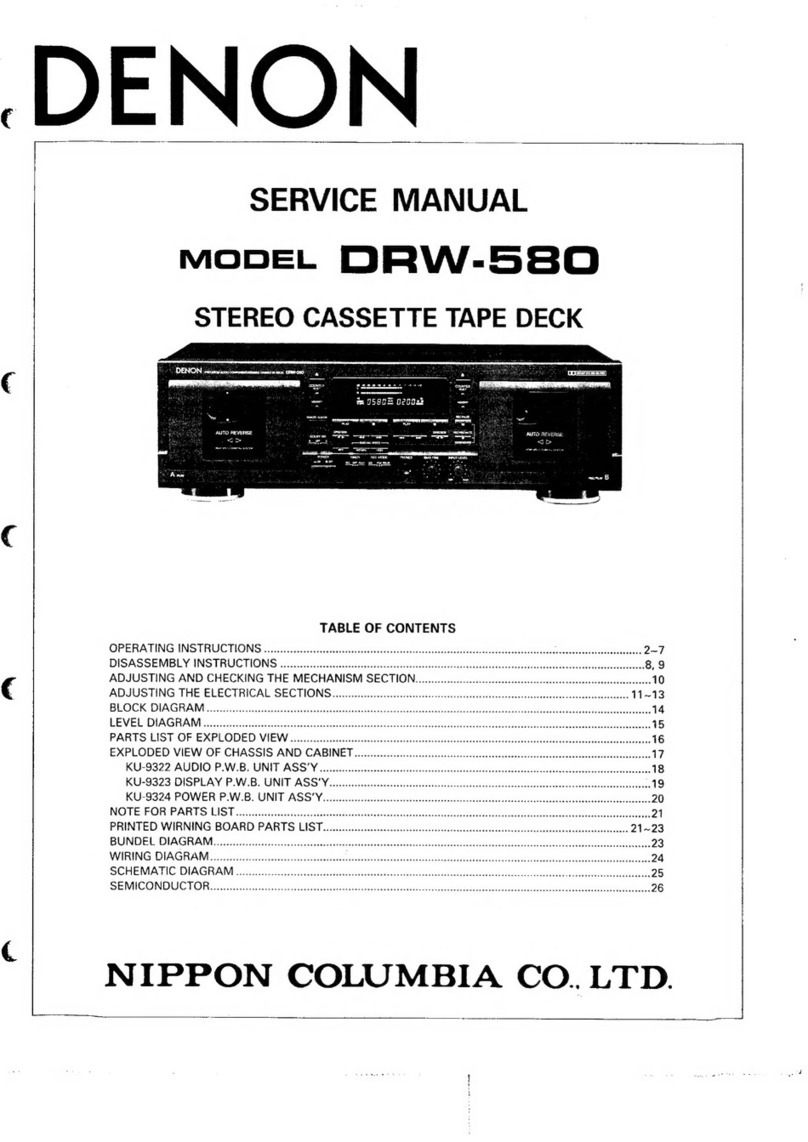
Denon
Denon DRW-5830 User manual
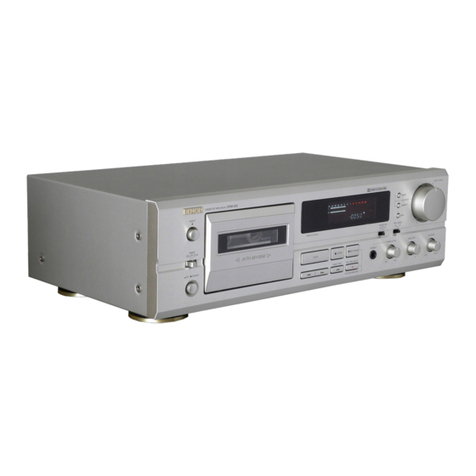
Denon
Denon DRM-595 User manual

Denon
Denon DRR-M30 User manual
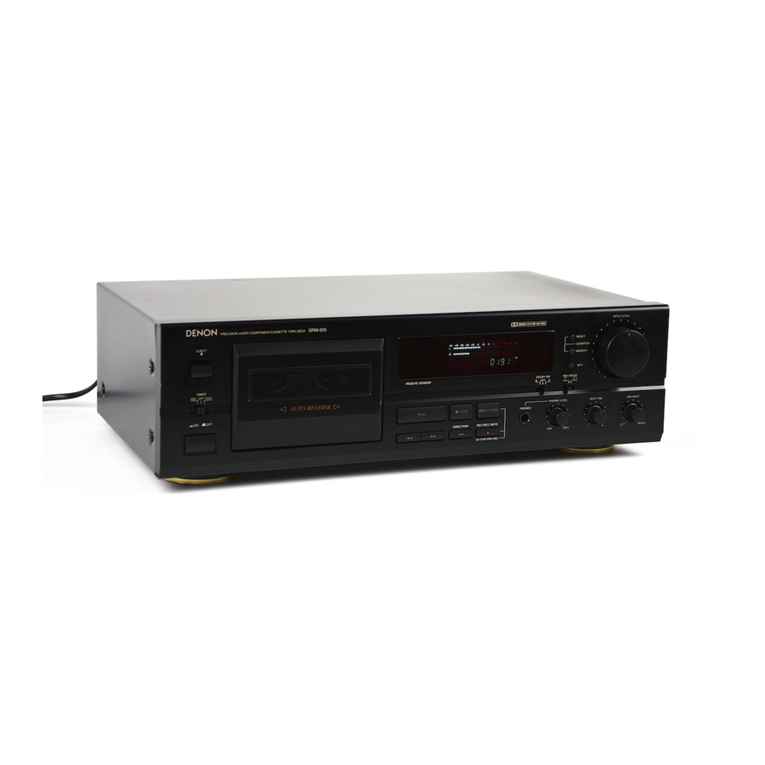
Denon
Denon DRM-555 User manual
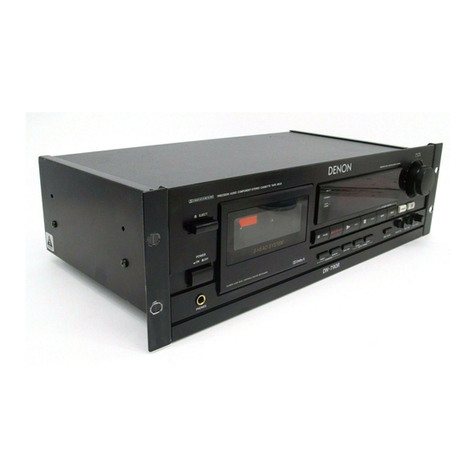
Denon
Denon DN-720R User manual
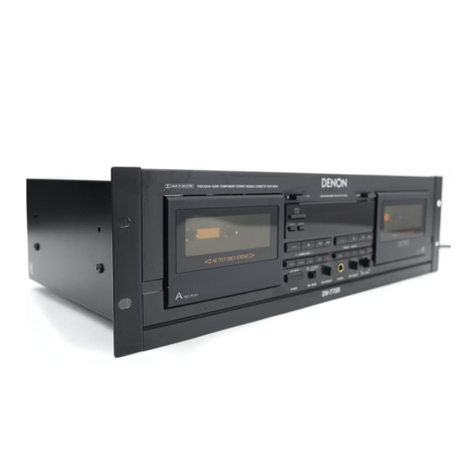
Denon
Denon DN-770R User manual

Denon
Denon DN-780R User manual

Denon
Denon DRW-695 User manual
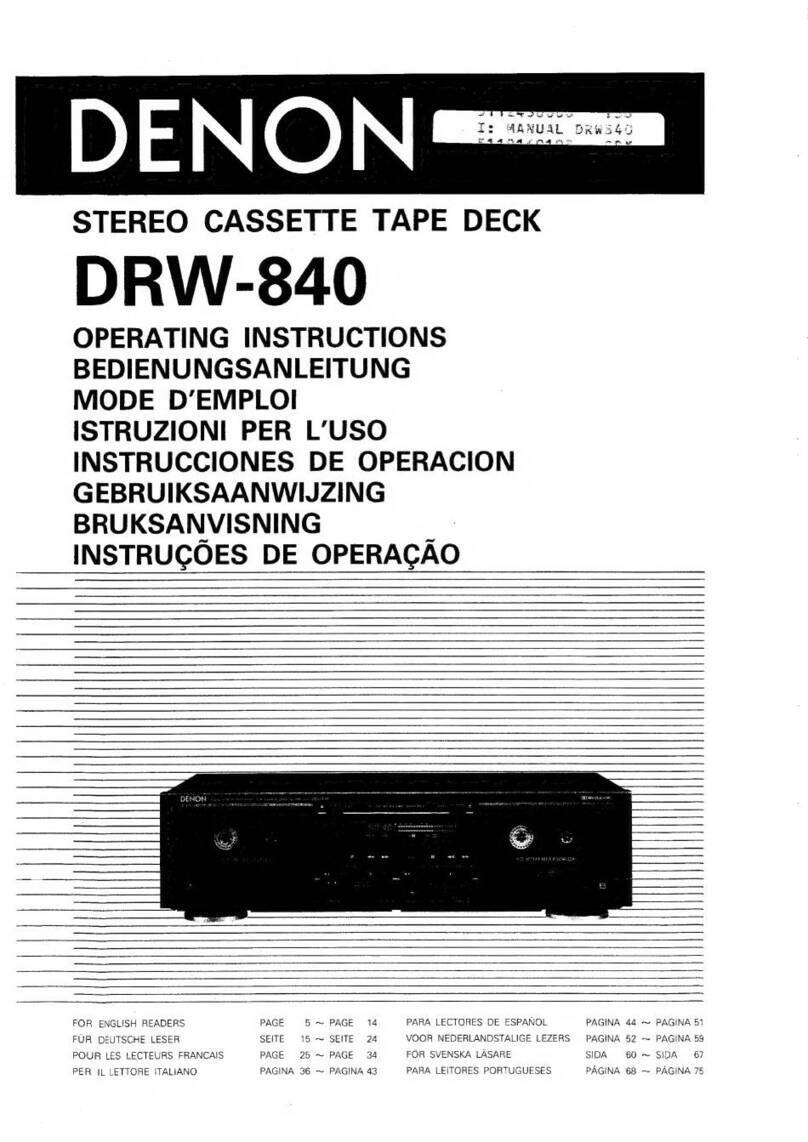
Denon
Denon DRW840 - Stereo Double Cassette Deck User manual
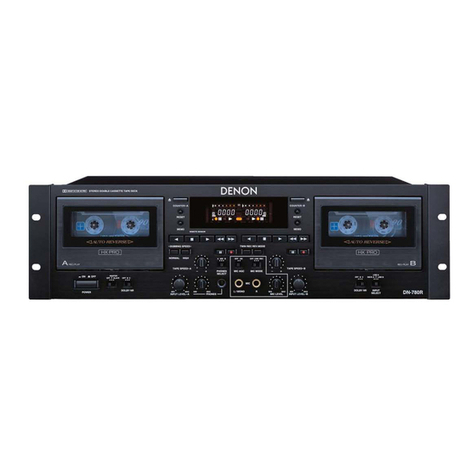
Denon
Denon DN-780R User manual
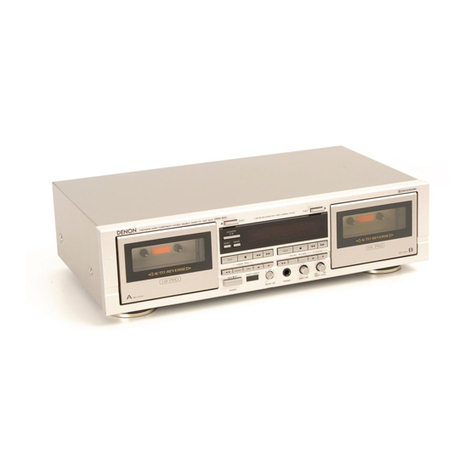
Denon
Denon DRW840 - Stereo Double Cassette Deck User manual

Denon
Denon DRW-585 User manual

Denon
Denon DR-M4 User manual

Denon
Denon DRM-550 User manual

Denon
Denon DRW-585 User manual
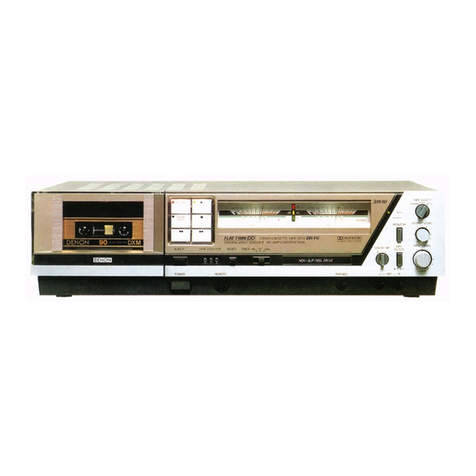
Denon
Denon DR-F6 User manual

Denon
Denon DN-730R User manual

Denon
Denon DR-M2 User manual
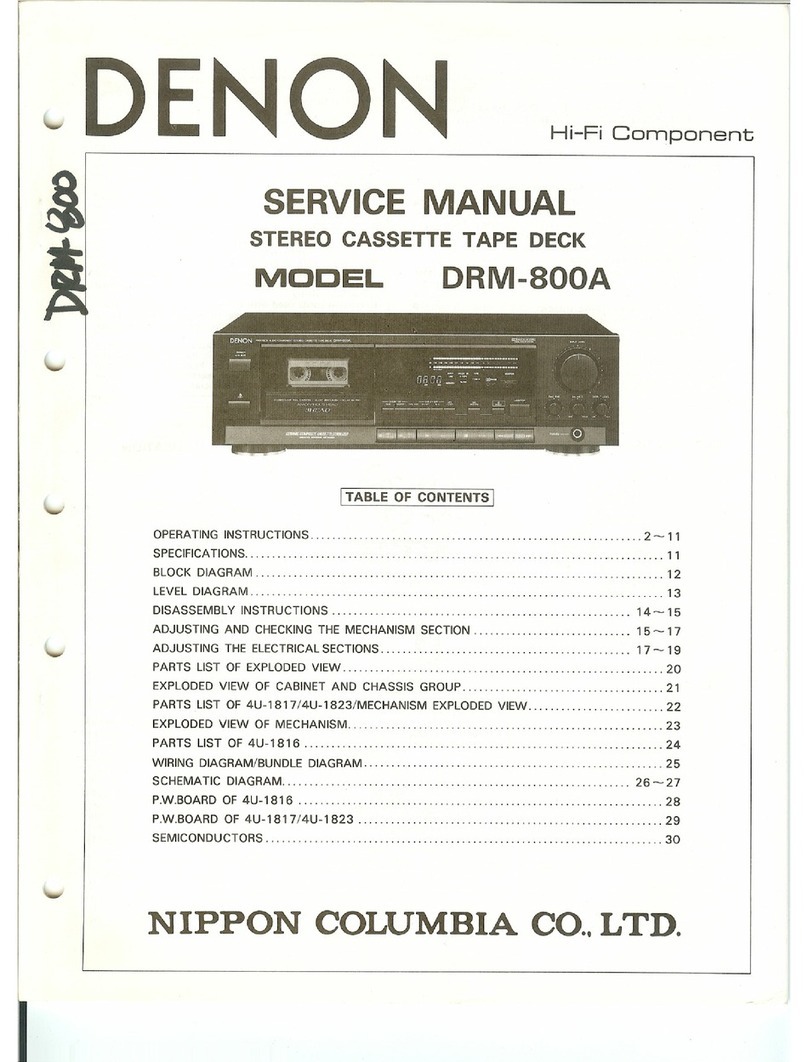
Denon
Denon DRM-800A User manual

Denon
Denon DN-780R User manual


